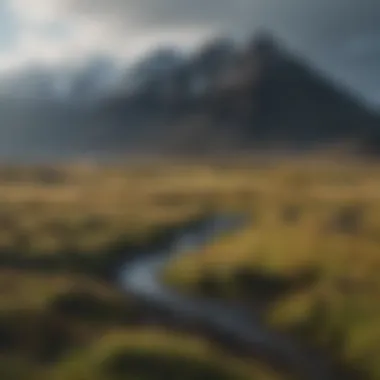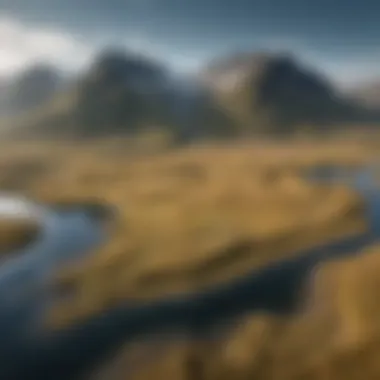Understanding Iceland's Climate: A Guide for Young Explorers


Nature Topic Overview
Understanding Iceland's weather is important for young explorers wishing to learn more about this unique island nation. Icelandic climate can be surprising. This country lies in the North Atlantic, filled with glaciers and volcanoes. Its location makes the weather variable and affected by the ocean currents and winds. Most people might imagine vast coldness, but Iceland offers a wide range of temperatures and weather patterns throughout the year. This adventure in understanding climate speaks to how our planet works. It is a perfect starting point for exploration.
Fun Facts and Trivia
- Geothermal Activity: Iceland has geysers like the famous Strokkur, shooting hot water into the air. It erupts every few minutes!
- Midnight Sun: In the summer, the sun does not set for weeks, meaning you can enjoy more time outside to play.
- Polar Nights: In winter, days can be very short, with sometimes just a few hours of daylight.
- Fauna of Glory: Over 300 types of birds nest in Iceland, making it a paradise for bird watchers.
A key mixture of visuals such as photographs or interactive maps about Iceland's weather will help young learners engage more effectively with the information.
Wildlife Explorations
In the realm of nature, Iceland is home to a range of fascinating species. Here are some highlights:
- Icelandic horse: A strong breed capable of unique gaits, ‘tölt’, allows them to be both smooth and fast.
- Puffin: A small bird with colorful beaks, known for diving into the sea to catch fish.
- Reindeer: Introduced in the 18th century, these animals can be seen in the wild.
These creatures are part of delicate ecosystems influenced by Iceland's climate. Engaging with puzzles about when these animals are most active or where they live helps keep knowledge fresh and fun for kids.
Environmental Awareness
It is vital to understand the importance of protecting habitats, especially given that Iceland's wild landscapes are influenced by climate change. Here’s why safeguarding these environments matters:
- Biodiversity: Protecting various species helps keep ecosystems strong.
- Climate Resilience: Healthier ecosystems are better able to handle changes in climate.
Children can contribute to conservation by:
- Saving water while brushing their teeth.
- Picking up litter at the beach or in local parks.
- Using both sides of paper when drawing or writing.
DIY Nature Activities
Hands-on learning solidifies information. Here are some activities that help unveil Iceland’s climate themes:
- Create a Weather Journal: Each day, students can draw or write about the weather in their area.
- Colorful Flags Craft: Use paper to create flags showing the current weather conditions. Use blue for rain, yellow for sun, etc.
- Birdwatching: Set up a day for exploring local parks, tracking birds you observe and comparing them to the birds of Iceland.
Experiencing the climate in a personal way makes knowledge lasting.
Preface to Icelandic Climate
Understanding the climate of Iceland is essential for anyone interested in the natural world. Climate influences everything in this beautiful country, from its unique ecosystems to human activities and settlements. Young explorers will find that grasping the elements of Iceland's climate enables them to appreciate how weather shapes their environment.
Overview of Iceland's Location
Iceland is an island country located in the North Atlantic Ocean. It sits just below the Arctic Circle, giving it a unique position in terms of climate.
- Geographic coordinates: 64°N latitude, 18°W longitude.
- Nearby countries: Greenland to the west, Norway to the southeast, and the UK to the south.
This location means Iceland is exposed to cold arctic air, yet the Gulf Stream moderates its climate. The interplay of these geographical factors creates varied climates across the island. Coastal areas tend to be milder, while the interior experiences more extreme conditions with colder temperatures.
Definition of Climate and Weather
To discuss Iceland’s climate closely, we should clarify two important terms: climate and weather. Understanding these concepts helps in interpreting the distinct atmospheric conditions present in Iceland.
- Weather: This refers to short-term atmospheric conditions. It involves day-to-day changes such as rain, sunshine, wind, or snow. Weather is not the same throughout the day; it can change quickly.
- Climate: Climate describes the long-term patterns in temperature, humidity, wind, and precipitation measured over a significant period, often recognized over years or decades. Iceland's climate is classified as subarctic and includes variations of oceanic influences.
The difference between climate and weather is crucial for young readers. Knowing what these terms mean assists in their comprehension of how Iceland's unique conditions impact life on the island.
Iceland's climate is unpredictable, illuminated by sudden weather changes that span from snowy gales to warm, sunny spells, all within a single day. This makes understanding climate vital for exploration.


Key Features of Iceland's Climate
Understanding the key features of Iceland's climate is essential for grasping how this unique environment influences daily life and natural systems. The climate is influenced by various factors including geographical features, ocean currents, and atmospheric conditions. Each characteristic interacts with others, creating a diverse and complex climate that has shaped Iceland's landscape and ecosystems over time.
Temperature Ranges
Iceland experiences a variation in temperature throughout the year. Generally, temperatures are milder than one might expect for such a northern country due to the warming influence of the Gulf Stream.
Winter Temperatures: In winter, average temperatures in Reykjavik hover around -1°C to 3°C, but they can fall much lower in remote areas. The coldest months stretch from December through February. Intensive snow can cover many parts, but it also melts quickly due to occasional warmer days.
Summer Temperatures: Summer months, particularly from June to August, bring more pleasant weather. Average temperatures can reach 11°C to 15°C. Yet, it is not unheard of to have days where it feels warmer.
This range of temperatures helps form a range of habitats across the island. Polar ecosystems in the north coexist with temperate zones in the south, both of which offer special challenges to flora and fauna found there.
Precipitation Patterns
Precipitation varies greatly across the country.
- General Observations: Western and southern coastal areas are typically wetter, receiving about 200-300 mm of rain annually during autumn and winter. Conversely, some central regions, like the interior, can be much drier, seeing as little as 50 mm.
- Seasonal Variance: Rainfall is generally heavier in winter, often accompanied by wet, windy storms. During summer, precipitation decreases but occasional rain can still occur. Some places even experience little to no rain for weeks.
Experiencing these precipitation patterns is crucial for understanding cloud formations in addition to impacting water resources for both wildlife and people.
Wind Patterns
Winds in Iceland play a critical role in its weather system.
General Winds: The prevailing winds come from the southwest. These winds influence both temperature and precipitation significantly, especially in coastal areas where reports can be published about sudden changes. It is common for landscapes can change quickly due to wind shifts.
- Impact on Temperature: These winds can lead to dramatic temperature drops, matterpads impending storms entering slowly across Iceland's geographical flows.
Wind is one key factor in shaping weather forecasting in Iceland, adding to the complex micrometeorologist theatre that this island offers.
Seasonal Variations in Iceland
Understanding the seasonal variations in Iceland is essential. Weather impacts daily life, from planning outdoor activities to the way people adapt their lifestyles each season. These variations showcase the diversity within the climate. Moreover, knowing these variations helps in comprehending how natural processes shape the landscape and ecosystems.
Winter Characteristics
Winter in Iceland brings forth distinct characteristics that define this season.
Temperature Trends
Temperature trends during the winter can fluctuate quite a bit. On average, temperatures range from -1 to 4 degrees Celsius. This fluctuation is valuable. Some areas are colder, while coastal regions often remain milder. The key characteristic of these trends is that, although chilly, they tend not to be as extreme compared to other regions at similar latitudes. This makes it suitable for various winter activities, including aurora sightings. Unique features include how volcanic activity occasionally keeps certain places warmer than their surroundings. However, travelers and residents need to stay cautious about rapid changes in temperature, which can occur.
Snowfall and Ice Coverage
Snowfall and ice coverage significantly affect the winter in Iceland. Many areas receive a thick, blanketing layer of snow that can reach up to 30 cm or even more. This is one important visual aspect that attracts many people. The unique aspect of snow coverage is that it transforms the landscape completely. While beautiful, heavy snowfall can cause disruptions to transportation. It is essential to be aware of how ice and snow can change daily routines. People must think about these conditions when making plans.
Summer Characteristics
Summer also presents its own features.
Temperature Trends
In summer, temperatures generally rise to between 10 and 15 degrees Celsius. Smaller coastal areas may see the temperature go higher, sometimes reaching 20 degrees. This aspect is pleasing, as it allows for various outdoor activities. The key feature within summer temperatures is their mild nature, encouraging exploration of the landscape. This trend is especially notable for young explorers who can participate in hiking and other adventures. However, some visitors might be surprised by how chilly it can feel when the wind picks up or during the evening hours. Hence, planning wardrobe options is important.
Daylight Hours


Daylight hours are another captivating feature of Icelandic summers. From late May to July, daylight lasts up to 24 hours in some parts. This phenomenon, known as the Midnight Sun, gives people ample time to engage with nature. This period promotes outdoor activities and encourages social gatherings. The unique feature of combined long days leads to an energized atmosphere. However, while enjoyable, not everyone is accustomed to the extended daylight, thus creating challenges in sleep patterns. It's important to realize how these factors shape the summer experience in Iceland.
Understanding seasonal variations offers valuable insight into Iceland's unique appeal and influences on daily life.
Seasonal variations in Iceland are educational. That understanding not just enhances nature appreciation but represents how climates transform landscapes and communities.
Geographical Influences on Climate
Understanding the geographical influences on Iceland's climate is crucial. Various natural features impact weather patterns, helping shape the ecosystems and wildlife of this unique island. This section unravel the dynamics of climate in Iceland, particularly how geographical context leads to diverse conditions.
The Role of the Gulf Stream
The Gulf Stream is a critical factor in Iceland's climate. It brings warmer water from the tropics to the North Atlantic. This current significantly influences temperatures, making non-arctic regions warmer than nearby areas.
Some important points regarding the Gulf Stream include:
- Moderates Temperatures: While Iceland is located close to the Arctic Circle, the Gulf Stream keeps average temperatures milder, especially during winter.
- Stimulates Vegetation Growth: Warmer waters support a wide range of plant species, allowing some vegetation to thrive that would otherwise not survive the harsh conditions.
- Affects Weather Patterns: The interaction between the warm Gulf Stream waters and cold Arctic air creates varied weather, leading to rain and unique cloud formations.
Nearly 50% of Iceland's coastal climate can be traced back to the Gulf Stream's warming effects.
Understanding the role of this current is vital for triates traveler and children hoping to know how climate life is shaped.
Mountain Ranges and Their Effect
Mountain ranges in Iceland also play a major role in shaping its climatic conditions. The island is crisscrossed by several significant mountains, and their presence can create distinct microclimates.
Some aspects to consider include:
- Rain Shadow Effect: Mountains can block moisture-laden winds, which means one side of the range may receive heavy rainfall. Meanwhile, the opposite side is often dry.
- Temperature Variation: Elevated areas tend to be cooler. Valleys sometimes experience warmer insulated microclimates that differ substantially from surrounding regions.
- Snow and Ice Formations: The mountains support glacier formations, which continue to influence local climates through reflection and absorption of sunlight, adding another layer to how the climate behaves.
Each feature of Iceland's geography intricately shapes the weather experienced by both the flora and fauna, providing a vibrant picture of how location uniquely informs climate.
Impact of Climate on Icelandic Ecosystems
Climate has a profound effect on ecosystems. In Iceland, this interaction shapes the unique qualities of both flora and fauna. Young explorers can appreciate how the climate influences plant life and animal behavior. Understanding these dynamics is crucial, as they reveal how species cope with challenges, adapt, and thrive in variable environments.
Flora Adaptations
Plants in Iceland are adapted to withstand harsh conditions. For instance, the Icelandic moss, known as Racomitrium lanuginosum, adds a lush touch to the landscape. It can survive extreme winds and freezing temperatures. Many plants have thick leaves that reduce water loss.
- Photosynthesis: Icelandic plants often complete photosynthesis with shorter daylight hours. They utilize available sunlight efficiently.
- Growth patterns: Many plants grow close to the ground to avoid damage from wind. This characteristic allows them to retain warmth and moisture.
- Diversity: Flowering plants like the arctic poppy show bright colors in the summer. Their dramatic colors attract pollinators vital for their reproduction.
A key point is that many of these plants have evolved to bloom during brief periods when conditions allow for growth.
Fauna Adaptations
Animals in Iceland must adapt consistently to changing climates. Species demonstrate remarkable adaptability to varying conditions. The Icelandic sheep, famous for their dense wool, are well-protected against cold. The insulating properties of their wool enable them to travel and thrive in winter conditions.
- Migration: Many birds, like the arctic tern, migrate to Iceland to escape winter climates. They return for breeding. This cycle supports ecological diversity.
- Dietary Adaptations: Animals, including seals and reindeer, adjust eating habits based on seasonal availability of food. In winter, they rely on mosses and lichens if green vegetation is inaccessible.
- Behavioral Changes: During foul weather, many mammals alter activity levels. For instance, foxes hunt more actively when conditions improve.
Icelandic fauna showcases the ongoing resilience present in diverse climates. Eco-adaptations reveal hidden strategies for survival.
The connection between climate and ecosystems is key to understanding how life can change and adjust over time.
Human Interaction with Iceland's Climate
Understanding how humans interact with Iceland's climate is key. This knowledge helps us see how everyday life and the environment are linked. Not only does Iceland's unique climate shape local livelihoods, but it also plays a significant role in influencing tourism.


Livelihoods and Climate
In Iceland, the climate determines what people can do for work and food. The fishing industry is very important. With cold ocean currents, the fish population thrives. Fishermen rely on these conditions. They know the best times to catch fish depend on temperature and weather patterns.
Agriculture in Iceland is challenging, too. The cold climate limits what crops can grow. Farmers often use greenhouses to cultivate vegetables and flowers. This adaptation shows resilience and innovation. People rely on sheep farming, reindeer herding, and dairy production. All these livelihoods correlate strongly with the clever use of resources offered by nature.
Some key points on livelihoods include:
- Fishing: Strong seasonality based on fish migration.
- Agriculture: Greenhouses are necessary to grow certain crops.
- Resource management: Sustainable practices help secure future resources.
Tourism and Climate Conditions
Tourism is a major part of Iceland's economy. Tourists come to see glaciers, geysers, and the northern lights. Weather patterns directly affect tourism by influencing travel plans, outdoor activities, and more. When it's cold or very windy, fewer visitors might explore the outdoor attractions. Tourists need to be aware of the weather.
Seasonal variations also impact tourism. Summer means long days with midnight sun, which is attractive. On the other hand, winter offers unique activities like snowmobiling and viewing the northern lights. Tour operators adjust their services based on climate conditions. This adaptation skills increase opportunities for both tourists and local businesses.
- Important considerations for tourism include:
- Unique attractions change with the seasons.
- Weather conditions vary from one region to another.
- Safety is a priority during extreme weather.
Understanding Iceland's climate helps locals and visitors make secure plans, ensuring enjoyable experiences.
In summary, examining human interactions with Iceland's climate reveals how inseparable they are. Livelihoods and tourism have adapted creatively to fit the changing climate. Recognizing these links can enhance how we appreciate and navigate Icelandic landscapes.
Future Climate Considerations
Understanding the future of Iceland's climate is essential. The rapidly changing climate can influence many aspects of life in this unique country. As explorers, it is key to consider both the challenges and opportunities that lie ahead. This knowledge helps young scientists and nature lovers understand their environment and take action for a sustainable future.
Climate Change Impact
Climate change is a significant concern for Iceland. Changes in temperature and precipitation can alter ecosystems, wildlife, and human activities.
- Rising Temperatures: Over the years, average temperatures in Iceland have increased. This warming can lead to melting glaciers and changing patterns in various water bodies. Many glaciers, which are large bodies of ice, are notably shrinking.
- Wildlife Effects: Different plants and animals might find it hard to adapt quickly to new conditions. Some species thrive in cold habitats, so rising temperatures may limit their habitat. Migration patterns of birds or the breeding season of fish can change. It is vital for us to monitor these shifts carefully.
“Ecosystems in Iceland are not just home to unique wildlife, but also show how interconnected nature is, reacting to changes in their environment.”
- Sea Level Rise: As polar ice melts, sea levels rise. This can cause coastal areas to face erosion and increased flooding. We must protect our coastlines and learn how to live with changes.
These impacts can influence communities, jobs, and local culture. Understanding them is vital for adapting and finding solutions.
Conservation Efforts
Conservation plays an important role in countering climate change effects. Individuals, organizations, and governments are taking action to protect Iceland’s natural beauty.
- Protected Areas: Many areas of Iceland are protected from development, allowing nature to thrive. National parks like Thingvellir are crucial for biodiversity. Safeguarding these places supports the various plant and animal life found there.
- Renewable Energy: Iceland is famous for its commitment to renewable energy sources. The majority of the country's electricity and heating comes from geothermal and hydropower. Using these clean energy options helps lower carbon emissions.
- Community Initiatives: Many local groups are active in restoration projects. They plant trees, clean up beaches, and promote education about climate issues. Raising awareness leads to better practices and encourages everyone to participate.
- Scientific Research: Ongoing scientific studies help us understand better how to protect the environment effectively. Support for research units means finding new ways to address climate issues is a priority.
Supporting conservation efforts and being mindful of choices can positively influence the future of Iceland's climate. Young explorers should feel empowered to contribute to these efforts.
Finale: The Significance of Understanding Climate
Understanding the climate of Iceland offers many important lessons. First, it reveals how geographical features govern weather patterns. Knowledge of these features is essential for insights into the natural systems of the island. Familiarity with the Icelandic climate also enhances appreciation for the delicate interplay between weather and living beings.
Climate knowledge benefits not just students but also the wider community. It informs sustainable practices. Those in Iceland need to know how climate dictates farming, fishing, and tourism.
There are key points that emerge when discussing the significance of climate understanding:
- Environmental Awareness: Learning about climate encourages children to develop a sense of responsibility for their environment. Promoting mindful exploration can lead to better stewardship.
- Ecosystem Connections: A deep understanding of how ecosystems operate can influence scientific curiosity. Young explorers become more engaged in recognizing flora and fauna adaptations.
- Adaptation and Resilience: Climate shapes how communities evolve. An understanding breaks down complexities of climate change and illuminates paths for adaptation.
Iceland’s climate, while unique, reflects broader global phenomena. Understanding climate prepares the next generation for facing challenges. Awareness can drive change, stemming from knowledge that prompts action. By elucidating local climates, students can connect with global efforts.
Ultimately, understanding climate is not just academic; it is foundational to fostering sustainable futures.
To summarize, grasping the significance of climate not only helps understand Iceland professionally, but also allows young explorers to embrace proactive approaches to environmental issues. Parents and educators can utilize this guide to spark curiosity about the world around us. It is important that young explorers learn how intertwined the climate is with life on the planet, preparing them for the challenges of tomorrow.







